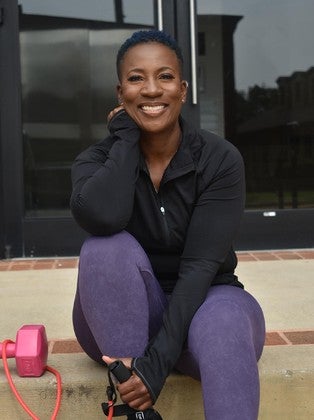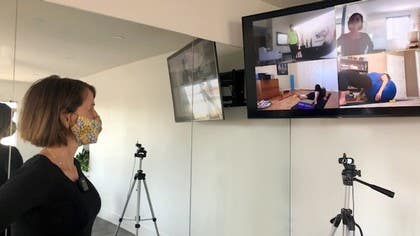
Fostering Social Connection in Online Fitness Classes
More than a year after we were forced to reimagine our teaching spaces, things are still not back to “normal.” Instead, we are being called upon to sharpen our skillset even more now that our new reality includes both in-person and online offerings. Our clients still want to be connected to us, no matter where we interact with them. How do we continue to cultivate community when our clients can be anywhere?
In 2019, only 7% of fitness consumers live-streamed workouts. Since the pandemic started in March of 2020, that number rose to 80%. With options such as live group classes via Zoom, Facebook and Instagram live, private sessions, and pre-recorded offerings (also known as “video-on-demand”), we have been able to help our clients keep moving. What’s been missing has been the community aspect: the casual interactions between students and colleagues that take place before and after class.
According to the National Alliance on Mental Illness, humans are social beings who depend on their communities for feelings of belonging, support, and purpose. Think about the retired Pilates client who lives alone, with children and grandchildren who live out of town, or the new client who has just started her practice and relies on the affirmation fellow clients offer. Think about the thoughtful client who brings you coffee every morning to show kindness as well as to feel needed. How can we find a way to engage and connect with our clients in ways that may be different from the ones we are accustomed to in our physical spaces? How do we translate community-building activities into the online space?
Some questions to consider:
- Where are our students hanging out online and do we interact with them there? Are our students Facebook, Pinterest, and Instagram lovers? Do they watch YouTube, listen to podcasts, or subscribe to blogs?
- What makes up the neighborhood in which your gym or studio is located? Are there coffee shops, boutiques, restaurants, artists, and bookstores that you could bring to your students in a virtual way?
- What type of things do your students enjoy when they are not taking Pilates? Are they wine connoisseurs, hikers, painters, writers, dancers, or Netflix fans? How do we bring these things to our virtual space?
After more than a year of lockdowns, depending upon your location, many of us have a love/hate relationship with our screens. But Zoom and other platforms like it have made it possible to see our people face to face. While seeing faces in little squares may not have the same emotional payoff as greeting friends with a handshake or hug in our physical space, there are ways we can maximize the feeling of connection in this virtual realm.
These include:
- Log into your Zoom sessions five to ten minutes early and allow everyone to have their microphones on so they can chat, or leave time at the end of class to connect. This gives everyone else the option to just log in at class time if they prefer to get right to the workout and skip the small talk.
- Leave the chat feature open for use during the class. The chat window is a great way for clients to communicate with each other and cheer one another on or acknowledge milestones such as someone’s birthday or first (or 100th) class.
- Enable breakout rooms. Breakout rooms allow clients to talk in small groups. It can also be used for icebreakers and other activities such as brainstorming.
When thinking about how to integrate the community around us, we can:
- Host virtual educational events. Do you know a doctor, financial advisor, artist, wellness coach, therapist, makeup artist, chiropractor, or chef who would be willing to speak to your community?
- Host social events. Do you know someone who would be awesome at hosting an online game night, leading an arts and crafts project, or facilitating an online book club? Maybe there’s a student who has an expertise that the other students would be interested in, whether it’s astrology readings or stand-up comedy.
- Host classes and workshops in outside modalities. Bring in guest instructors to teach things you don’t usually offer such as salsa or ballroom dance, yoga, tai chi, barre, boxing, or boot camp.
- Spotlight like-minded small businesses on your studio website. Perhaps your studio’s website can include links to neighborhood businesses, interviews with local merchants, or mentions of new shops and services in the area that would appeal to your clientele. Think about yarn/craft stores, pet services, artisanal food and beverage merchants, independent boutiques, and providers of beauty services.
Other options for cultivating a sense of community and belonging include creating private Facebook groups or group texts on platforms such as WhatsApp and GroupMe.
Just as in lockdown we’ve discovered innovative ways to cue movement without using our hands, we’ve also discovered a multitude of ways to communicate while staying physically distant. The beauty of this kind of pandemic-induced creativity is that if something resonates for you and your clients, you can keep it going in the non-virtual space once businesses and life as we knew it open up once again.
As studio doors swing open again, clients will be understandably anxious to get back to their Reformers. If we’ve been able to harness our technological resources to create a sense of connection and community online, those same clients may come back feeling as if they never left.
How are you enabling clients to stay connected during online learning? Let us know in the comments below.
Comments
No comments yet. Be the first!












You need to be a subscriber to post a comment.
Please Log In or Create an Account to start your free trial.